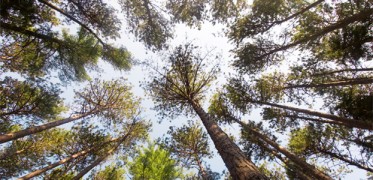Functioning Family Forests

Finding more efficient ways to serve Maine landowners by incorporating social work strategies — including effective communication and resource- linking skills — into forest management is the goal of a collaborative project between researchers at two schools in the University of Maine College of Natural Sciences, Forestry, and Agriculture.
Jessica Leahy, an associate professor of human dimensions of natural resources in the UMaine School of Forest Resources, is leading the study that tests social work approaches to conservation in the Cumberland County town of Baldwin and surrounding communities. Researchers hope to determine if these strategies could lead to more effective outcomes to landowners’ challenges as opposed to using traditional forestry solutions, such as management plans and outreach materials.
“Social workers are good at listening to people — understanding their needs and connecting people to appropriate resources,” Leahy says. “That’s why we need social workers to help landowners; to listen to what they’d like to do with their land, and then connect and coordinate services from natural resource professionals.”
There are more than 85,000 families in Maine that own at least 10 acres of woods, Leahy says. Their needs can be addressed by UMaine, the Maine Forest Service and others if those organizations can provide services that work for landowners, she adds.
Many conservation problems are related to social and economic factors. While foresters and other natural resource professionals help landowners make decisions about land management, they may not be equipped to handle the challenges landowners face that involve family dynamics. A social work approach could be the answer to solving these conservation problems, Leahy says.
“Foresters specialize in land management and trees, but landowners are often dealing with human issues such as how to afford their taxes and how to talk to their family about what they’d like to happen with their land after they pass away,” she says. “Landowners also often don’t know what a forester can do for them nor do they know how to coordinate all the potential natural resource professionals that are there to help them.”
Leahy, the project’s forestry expert, hired Doug Robertson and Chris Young, students in the UMaine School of Social Work. Both Robertson, a senior in the bachelor’s of social work program from Benton, Maine, and Young, a first-year graduate student of social work from Bangor, Maine, grew up around Maine woodland owners. They’re interested in connecting with landowners through the project and learning more about the land that many families rely on and how community organizations can help.
Pam Wells, a licensed clinical social worker, is supervising the students and translating the social work aspect of the project. She is also a landowner who recognizes areas where social work and forestry intersect.
“Pam often talks about how challenging it is to find, understand and coordinate the various assistance programs that are out there for landowners like the Tree Growth Tax Law, Natural Resources Conservation Service cost-share programs and programs offered by the Maine Forest Service,” Leahy says.
Kevin Doran and Andy Shultz of the Maine Forest Service are also helping with the study.
The one-year project, which began in Sept. 2013 and runs through August 2014, received a $6,500 Maine Community Foundation grant. The project’s social work approach to conservation has been untested to date, Leahy says.
“It’s an innovative, highly experimental, never-been-done-before project that is bridging forestry and social work together in an effort to better engage and serve rural families who own forestland in southern Maine,” she says.
Part of the project will include the development of a forest-specific wraparound case management process that will be implemented with one landowning family. The wraparound process in social work recognizes that all aspects of someone’s life — social, economic and ecological — are related. This understanding is then used to help the individual by focusing on incremental progress, involving community support and using science-based interventions, according to Leahy.
The focus of the project will be on measuring and evaluating the outcomes of the approach to improve future efforts.
“Ultimately, we hope more landowners will be empowered to be stewards of their land, and that will lead to healthy forests, healthy rural economies and healthy families,” Leahy says.
Other aspects of the community project include assisting the Small Woodland Owners Association of Maine with succession planning efforts, offering peer-to-peer learning experiences such as suppers and forums, organizing workshops for natural resource professionals to increase their cultural competency and researching community interest in creating a low-income wood bank — similar to a food bank — for the Baldwin area.
Upcoming peer-to-peer learning events include the project’s second woods forum and community supper Feb. 7, a workshop on estate planning for landowners Feb. 27 and a Forester’s Institute brown bag lunch on cultural competency April 11.
Robertson and Young are looking for a family to work with on the project. Interested families must live in Sebago, Hiram, Cornish, Limington, Baldwin or Standish and own at least 10 acres. To participate or for more information on the project or scheduled workshops, call Robertson, 207.435.4798, or Young, 207.992.6182.
